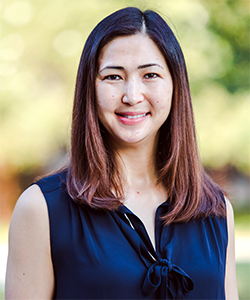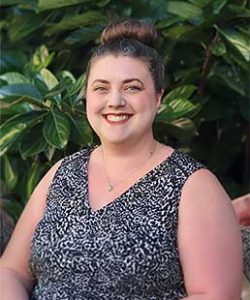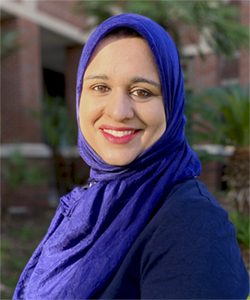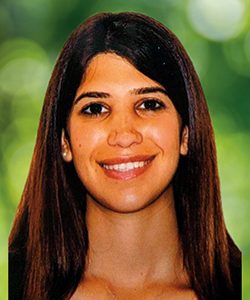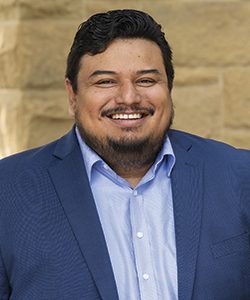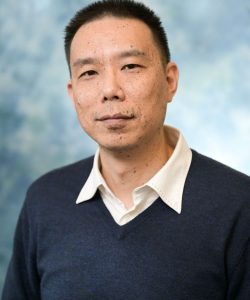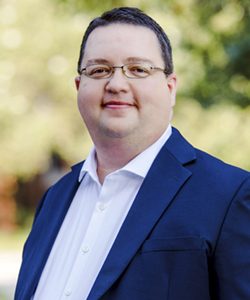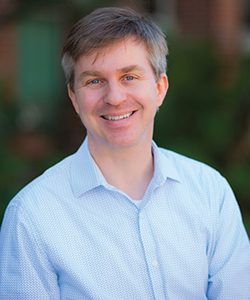The Department of Materials Science & Engineering at the University of Florida is at the forefront of innovation, tackling some of the most pressing challenges in science and technology. Our faculty lead cutting-edge research in a wide range of materials fields, from designing next-generation biomaterials for medical applications to advancing metallurgy for aerospace and manufacturing. Students have the opportunity to work alongside experts developing high-performance ceramics, exploring the potential of nanomaterials for energy and electronics, and pushing the boundaries of nuclear fusion technology.
Our department is also a radiochemistry and nuclear security leader, focusing on critical issues such as radiation detection and nuclear safeguards. Whether investigating materials for extreme environments, enhancing non-destructive inspection techniques, or pioneering sustainable materials solutions, our research spans fundamental discoveries to real-world applications. With state-of-the-art facilities and strong industry and government partnerships, we provide an exceptional environment for students to engage in impactful, hands-on research that shapes the future of materials science and engineering.
Researchers use various traditional techniques (e.g., scanning electron microscopy, energy dispersive spectroscopy and electron backscatter diffraction) to capture microstructural evolution in nuclear fuels and materials. However, these surface-based methods do not accurately capture the complex microstructure of the fuel. We utilize new tomography-based techniques on nuclear fuels which yield information on grains, fission products and porosity structure in 3D. This data can be used as input to new phase-field models to predict fuel performance in a reactor.
Faculty

Education: Ph.D., 2017, University of California, Santa Barbara
Research Interests: energy storage materials, functional and electronic materials, lithium-ion batteries, structure-property relationships, X-ray diffraction, pair distribution function analysis, local structure, amorphous and disordered materials
Lab Website: Butala Research Group

Education: Ph.D., 1987, University of California-Berkeley
Research Interests: Electronic materials, semiconductor processing and characterization, ion implantation, transmission electron microscopy.
Lab Website: Swamp Group
Impact of Materials on Society (IMOS) is on Instagram!
Dr. Kevin S. Jones is a Distinguished Professor and holds the Fredrick N Rhines Chair in the Department of Materials Science and Engineering (MSE) at UF.…

Ph.D., 2015, University of Illinois at Urbana-Champaign
Research Interests: Advanced electron microscopy techniques, Quantitative analysis of electron microscopy data, Digital image processing, Understanding materials properties at the atomic scale, Functional oxides and semiconductors
Lab Website: Kim Electron Microscopy Group
The study of biomaterials applies to all materials that interact with the human body, and at UF, we are at the forefront of biomaterial development and commercialization. Our research tackles tissue regeneration, degradable bioceramics, metal implants and more. We also study biomaterials for bone repair, to heal wounds, treat cancer and even test some of them in space!
Faculty

Ph.D., 2008, University of California, Santa Barbara
Research Interests: nanomaterials, nanocomposites for electronic and biomedical applications, magnetic materials, multiferroics, polymers
Lab Website: Andrew Research Group

Education: Ph.D. 2019, University of Akron
Research Interest: Computational Soft Materials, Structure-Property Relation of Soft Materials, Polymer Physics, Bio-Inspired and Biomimetic Materials, Sustainable Polymers, Colloidal Suspensions.
Website: The Liang Lab
Ceramics have unique characteristics (e.g., high resilience and strength, tunable electronic and ionic transport, bio-compatibility, ferroelectric response) that make them desirable for a variety of different applications. At UF, ceramics research tackles material design and processing challenges related to gas-turbine engines, battery materials, nuclear energy, drug delivery, and many more!
Faculty

Ph.D., 2008, University of California, Santa Barbara
Research Interests: nanomaterials, nanocomposites for electronic and biomedical applications, magnetic materials, multiferroics, polymers
Lab Website: Andrew Research Group

Education: Ph.D., 2017, University of California, Santa Barbara
Research Interests: energy storage materials, functional and electronic materials, lithium-ion batteries, structure-property relationships, X-ray diffraction, pair distribution function analysis, local structure, amorphous and disordered materials
Lab Website: Butala Research Group

Ph.D., 2015, University of Illinois at Urbana-Champaign
Research Interests: Advanced electron microscopy techniques, Quantitative analysis of electron microscopy data, Digital image processing, Understanding materials properties at the atomic scale, Functional oxides and semiconductors
Lab Website: Kim Electron Microscopy Group

Education: Ph. D., 2002, The Pennsylvania State University
Research Interests: sustainable material synthesis; advanced functional ceramics; nuclear energy; applied and explainable AI in materials science, neuromorphic memory, connectomics and graph theory, single crystal growth, materials under extreme environments; radiation effects on electronics; plant-derived materials; bioceramics.
Lab Website: Nino Research Group (NRG)

Ph.D., 1992, Johannes Gutenberg University of Mainz, Germany
Research Interests: Semiconductor oxides for energy harvesting and storage, photocatalysis and photolysis, electrodes for secondary batteries, barrier coatings, nanostructures in surface science and, biomedical applications of nanoparticles
Lab Website: Sigmund’s Group
Computational materials science uses modeling and simulation to study material behavior and properties at length scales ranging from atomic to mesoscale and ultimately to the engineering scale. At UF, computational materials science research focuses on multiple scientifically challenging areas important for applications, including 2D materials, defects and interfaces, superconductivity, materials in extreme conditions, and nuclear materials. We also take advantage of UF’s HiperGator supercomputer in our work.
Faculty

Education: Ph.D. 2019, University of Akron
Research Interest: Computational Soft Materials, Structure-Property Relation of Soft Materials, Polymer Physics, Bio-Inspired and Biomimetic Materials, Sustainable Polymers, Colloidal Suspensions.
Website: The Liang Lab

Education: Ph.D., 1985, University of Florida
Research Interests: Computational materials science, nuclear materials, defect properties, framework materials, sequestration of radionuclides, layered materials, simulation methodologies
Lab Website: Phillpot Research Group

Ph.D., 2010, Penn State University
Research Interests: Reactor Kinetics and Dynamics, Neutronics, Thermal Hydraulics, Multiphysics Simulation, Advanced Numerical Methods, Applied Mathematics, Advanced Code Coupling Techniques, Scientific Software Development, High Performance Computing
Lab Website: Florida Advanced Multiphysics Modeling and Simulation (FAMMoS) Lab
Computational – NE Faculty

Education: Ph.D. 2019, University of Akron
Research Interest: Computational Soft Materials, Structure-Property Relation of Soft Materials, Polymer Physics, Bio-Inspired and Biomimetic Materials, Sustainable Polymers, Colloidal Suspensions.
Website: The Liang Lab

Education: Ph.D., 2008, University of California San Diego
Research Interests: Computational plasma physics, magnetic fusion, tokamak disruptions, scientific machine learning, plasma-material interaction.
Lab Website: McDevitt Lab

Ph.D., 2010, Penn State University
Research Interests: Reactor Kinetics and Dynamics, Neutronics, Thermal Hydraulics, Multiphysics Simulation, Advanced Numerical Methods, Applied Mathematics, Advanced Code Coupling Techniques, Scientific Software Development, High Performance Computing
Lab Website: Florida Advanced Multiphysics Modeling and Simulation (FAMMoS) Lab
Electronic Materials research encompasses a variety of materials, including semiconductors, magnetic materials, and optical materials. They can be both inorganic and organic. The most common applications for electronic materials are computer chips, optical devices such as LEDs and diode lasers, sensors, and materials designed to take advantage of unique quantum properties. At UF, we’re examining novel methods of creating and doping semiconductors and growing interesting new materials with unique magnetic and electrical properties for future devices. We’re even investigating ways of making organic photovoltaic devices that may promise inexpensive energy harvesting.
Faculty

Education: Ph.D., 2017, University of California, Santa Barbara
Research Interests: energy storage materials, functional and electronic materials, lithium-ion batteries, structure-property relationships, X-ray diffraction, pair distribution function analysis, local structure, amorphous and disordered materials
Lab Website: Butala Research Group

Ph.D., 2006, University of Florida
Research Interests: Growth and Characterization of Wide and Ultra-wide Bandgap Semiconductor Materials

Education: Ph.D., 1987, University of California-Berkeley
Research Interests: Electronic materials, semiconductor processing and characterization, ion implantation, transmission electron microscopy.
Lab Website: Swamp Group
Impact of Materials on Society (IMOS) is on Instagram!
Dr. Kevin S. Jones is a Distinguished Professor and holds the Fredrick N Rhines Chair in the Department of Materials Science and Engineering (MSE) at UF.…

Education: Ph. D., 2002, The Pennsylvania State University
Research Interests: sustainable material synthesis; advanced functional ceramics; nuclear energy; applied and explainable AI in materials science, neuromorphic memory, connectomics and graph theory, single crystal growth, materials under extreme environments; radiation effects on electronics; plant-derived materials; bioceramics.
Lab Website: Nino Research Group (NRG)

Ph. D., 1989, Louisiana State University
Research Interests: Electronic, photonic, and magnetic thin film materials; electronic oxide materials; thin film deposition

Ph.D., 2005, Princeton University
Research Interests: Nanostructured electronic materials, organic-inorganic hybrid materials, surfaces and interfaces, energy materials, photovoltaic cells, light-emitting diodes and other optoelectronic devices
Lab Website: Xue Research Group
Whether the focus is sustainable energy generation, conversion, or storage, including electrical energy generation via solar and other renewable sources, or how to transfer and store energy between its generation and use, materials science and engineering play a key role.
Our research includes selecting, designing, and manufacturing advanced materials for these energy applications, such as organic and inorganic photovoltaics, and energy conversion and storage in batteries, fuel cells, and capacitors. We also evaluate and develop processes and materials for the safe disposal of energy materials (e.g., nuclear fuels, lithium, rare earth) and their circular economy.
Faculty

Education: Ph.D., 2017, University of California, Santa Barbara
Research Interests: energy storage materials, functional and electronic materials, lithium-ion batteries, structure-property relationships, X-ray diffraction, pair distribution function analysis, local structure, amorphous and disordered materials
Lab Website: Butala Research Group

Education: Ph.D., 1987, University of California-Berkeley
Research Interests: Electronic materials, semiconductor processing and characterization, ion implantation, transmission electron microscopy.
Lab Website: Swamp Group
Impact of Materials on Society (IMOS) is on Instagram!
Dr. Kevin S. Jones is a Distinguished Professor and holds the Fredrick N Rhines Chair in the Department of Materials Science and Engineering (MSE) at UF.…

Education: Ph. D., 2002, The Pennsylvania State University
Research Interests: sustainable material synthesis; advanced functional ceramics; nuclear energy; applied and explainable AI in materials science, neuromorphic memory, connectomics and graph theory, single crystal growth, materials under extreme environments; radiation effects on electronics; plant-derived materials; bioceramics.
Lab Website: Nino Research Group (NRG)

Ph.D., 1993, University of Paris, XI
Research Interests: Radiochemistry, Nuclear Wastes, Nuclear Forensics, Nuclear Fuel Cycle, Environmental Behavior of Radionuclides
Lab Website: Wall Research

Ph.D., 2005, Princeton University
Research Interests: Nanostructured electronic materials, organic-inorganic hybrid materials, surfaces and interfaces, energy materials, photovoltaic cells, light-emitting diodes and other optoelectronic devices
Lab Website: Xue Research Group
Across the United States, educators are being asked to teach increasingly complicated subject material related to engineering concepts and technology, and unfortunately, few schools of education prepare teachers at a level of understanding that allows students to build conceptual models for these ideas.
Our work focuses on and develops pedagogical, professional development, and coaching models that support teachers in effectively teaching complex material to students so that students build out vital conceptual models that can be deployed in real-world applications.
Faculty

Ph.D., 2003, Tulane University
Research Interests: Engineering education, characterization techniques, surface physics, solid-state devices, dye-sensitized solar cells.
As the artificial intelligence and machine learning revolution permeates every aspect of our lives, materials science and engineering is no exception. In fact, at the University of Florida, we are both developing and applying AI/ML tools for designing, fabricating, and characterizing advanced materials with optimized performance.
Whether by developing and implementing high throughput genetic algorithms, deep neural networks for structure-property relationship identification and analysis, or image segmentation and generative models for microscopy, we are leading the AI/ML revolution in materials.
Faculty

Education: Ph.D. 2019, University of Akron
Research Interest: Computational Soft Materials, Structure-Property Relation of Soft Materials, Polymer Physics, Bio-Inspired and Biomimetic Materials, Sustainable Polymers, Colloidal Suspensions.
Website: The Liang Lab

Education: Ph.D., 2008, University of California San Diego
Research Interests: Computational plasma physics, magnetic fusion, tokamak disruptions, scientific machine learning, plasma-material interaction.
Lab Website: McDevitt Lab

Education: Ph. D., 2002, The Pennsylvania State University
Research Interests: sustainable material synthesis; advanced functional ceramics; nuclear energy; applied and explainable AI in materials science, neuromorphic memory, connectomics and graph theory, single crystal growth, materials under extreme environments; radiation effects on electronics; plant-derived materials; bioceramics.
Lab Website: Nino Research Group (NRG)

Ph.D., 2010, Penn State University
Research Interests: Reactor Kinetics and Dynamics, Neutronics, Thermal Hydraulics, Multiphysics Simulation, Advanced Numerical Methods, Applied Mathematics, Advanced Code Coupling Techniques, Scientific Software Development, High Performance Computing
Lab Website: Florida Advanced Multiphysics Modeling and Simulation (FAMMoS) Lab
Materials processing is a core research area in materials science and engineering, focusing on how raw materials are transformed into functional materials and components with tailored properties. This encompasses a wide range of techniques, including casting, forging, additive manufacturing, and thin-film deposition, each designed to control a material’s structure at various length scales. We work to develop new fabrication methods, optimize existing manufacturing processes, and understand the fundamental mechanisms that govern material behavior during processing.
At UF, our faculty explore both traditional and emerging processing technologies. They study how factors like temperature, pressure, and processing speed influence material performance, often integrating computational modeling and advanced characterization techniques to refine processes. Research efforts may focus on sustainability—such as energy-efficient processing methods or recycling strategies—or on next-generation materials, including high-entropy alloys, bioinspired composites, and semiconductor materials. Collaboration with industry partners and national laboratories is common, ensuring that discoveries lead to real-world applications in aerospace, automotive, biomedical, and electronic industries.
Faculty

Ph.D., 2008, University of California, Santa Barbara
Research Interests: nanomaterials, nanocomposites for electronic and biomedical applications, magnetic materials, multiferroics, polymers
Lab Website: Andrew Research Group

Ph.D., 1992, Johannes Gutenberg University of Mainz, Germany
Research Interests: Semiconductor oxides for energy harvesting and storage, photocatalysis and photolysis, electrodes for secondary batteries, barrier coatings, nanostructures in surface science and, biomedical applications of nanoparticles
Lab Website: Sigmund’s Group
Despite thousands of years of engineering use, the process of developing or selecting a new alloy and process for a given application is far from straightforward. Metals research at UF is focused on designing new alloys and processes for extreme environments, including hypersonic flight, nuclear reactors, space exploration, and blast impacts. Other avenues of metals research focus on biocompatible implantable alloys or flexible, stretchable metallic circuits for wearable electronics.
Faculty
The properties of most materials, such as their ability to emit light or bind to specific molecules, change dramatically when they are shrunk from the macro-scale down to the nano-scale (1 nanometer = 1 billionth of a meter). Sometimes, we can even stabilize materials at the nanoscale in structures that cannot be formed in larger “bulk” samples. Here at UF, we create nanomaterials with unique structures and properties that allow us to engineer new solutions to current challenges in biomedicine, electronics, energy storage, and catalysis.
Faculty

Ph.D., 2008, University of California, Santa Barbara
Research Interests: nanomaterials, nanocomposites for electronic and biomedical applications, magnetic materials, multiferroics, polymers
Lab Website: Andrew Research Group
Nuclear fuels and materials is the study of material behavior in radiation and reactor environments, including defect formation and evolution, fission product behavior, environmental degradation, and high-temperature behavior. At UF, we apply experimental and computational approaches to investigate oxidation and corrosion, light-water reactor (LWR) and advanced fuel behavior, radiation damage in 2D and functional materials, and radiation behavior of structural materials. We use advanced facilities at UF, including microscopy facilities for radioactive materials and the HiperGator supercomputer.
Faculty

Education: Ph.D., 1985, University of Florida
Research Interests: Computational materials science, nuclear materials, defect properties, framework materials, sequestration of radionuclides, layered materials, simulation methodologies
Lab Website: Phillpot Research Group

Ph.D., 1993, University of Paris, XI
Research Interests: Radiochemistry, Nuclear Wastes, Nuclear Forensics, Nuclear Fuel Cycle, Environmental Behavior of Radionuclides
Lab Website: Wall Research

Education: Ph. D., 2005, University of Wisconsin-Madison
Research Interests: structural and fuel materials for nuclear energy systems; LWRs sustainability and aging management; advanced fabrication and joining technologies; used fuel dry storage and disposition.
Lab Website: MAterials for Nuclear Advancement and Technology in Extreme Environments (MANATEE) Group
Nuclear fusion carries the potential for a safe, plentiful, and non-carbon-emitting source of energy. Science has made significant progress toward demonstrating the controlled release of fusion energy, but substantial scientific and technological obstacles to the practical realization of a fusion reactor remain. These include the presence of violent plasma instabilities leading to the sudden termination of the fusion discharge, localized thermal loads limiting the lifetime of critical components, and the turbulent transport of heat, particles, and momentum. Our research in this area focuses on describing the fundamental plasma processes underlying these challenges and identifying their impact on fusion components.
Faculty

Education: Ph.D., 2008, University of California San Diego
Research Interests: Computational plasma physics, magnetic fusion, tokamak disruptions, scientific machine learning, plasma-material interaction.
Lab Website: McDevitt Lab
Research in nuclear security and safeguards aims to keep our societies safe from the impacts of nuclear materials while enabling secure, beneficial use of nuclear materials and technologies. Ensuring that nuclear materials and technology are used solely for peaceful purposes is one of our society’s most pressing challenges. Therefore, efforts are urgently needed to ensure the timely detection and understanding of the signatures of nuclear proliferation, including the detection and characterization of nuclear materials at all stages of the nuclear fuel cycle.
Our mission is to meet this challenge by developing advanced tools to improve detection and timeliness for decision-makers and skilled talent for careers in nuclear security and nonproliferation. This includes areas such as stewardship programs, detection of illicit or clandestine nuclear programs, and radiation signature detection systems. Also, applications that can discover lost and orphaned nuclear sources. Implementation examples of such technology can be found in air- and sea ports, nuclear facilities, and national and international monitoring stations.
Faculty

Research Interests: Applied aspects of cargo monitoring, detector testing and characterization for gamma-ray spectroscopy, as well as development and analysis of techniques for environmental sampling and surveys related to on-site inspections.

Education: Ph.D., 2010, Chalmers, University of Technology, Sweden
Research Interests: Nuclear safeguards. Nuclear fuel cycle. Non-proliferation. Radiation detector characterization. Neutron physics & detectors. Neutron noise signals. Radiation signal analysis. Nuclear training. Radiation detection applications. and Materials Control and Accountability.
Lab Website: Enqvist Research Group

Education: Ph.D., 2016, Pennsylvania State University
Research Interests: Remote Sensing, Machine Learning, Radiation Interaction and Detection, Nuclear Nonproliferation, Forensics, Security, and Policy.
Lab Website: Hartig Research Group

Education: Ph. D., 2002, The Pennsylvania State University
Research Interests: sustainable material synthesis; advanced functional ceramics; nuclear energy; applied and explainable AI in materials science, neuromorphic memory, connectomics and graph theory, single crystal growth, materials under extreme environments; radiation effects on electronics; plant-derived materials; bioceramics.
Lab Website: Nino Research Group (NRG)

Ph.D., 1993, University of Paris, XI
Research Interests: Radiochemistry, Nuclear Wastes, Nuclear Forensics, Nuclear Fuel Cycle, Environmental Behavior of Radionuclides
Lab Website: Wall Research

Ph.D., 2005, Princeton University
Research Interests: Nanostructured electronic materials, organic-inorganic hybrid materials, surfaces and interfaces, energy materials, photovoltaic cells, light-emitting diodes and other optoelectronic devices
Lab Website: Xue Research Group
Polymers are an incredibly versatile class of materials that includes natural polymers—e.g., proteins and polysaccharides—and synthetic polymers such as polyethylene. Polymers are all around us; they are found in our clothing, cars, computers, shampoos, diapers, packaging, etc. In addition, they are crucial components of many advanced applications in energy, filtration, tissue engineering, and nanomedicine.
At UF, we engineer polymers to deepen our fundamental understanding of their physical behavior and solve energy storage, healthcare, and sustainability problems.
Faculty

Ph.D., 2008, University of California, Santa Barbara
Research Interests: nanomaterials, nanocomposites for electronic and biomedical applications, magnetic materials, multiferroics, polymers
Lab Website: Andrew Research Group

Ph.D., 2019, University of Minnesota
Research Interests: Dynamic Networks, Polyesters, and Biodegradation

Education: Ph.D. 2019, University of Akron
Research Interest: Computational Soft Materials, Structure-Property Relation of Soft Materials, Polymer Physics, Bio-Inspired and Biomimetic Materials, Sustainable Polymers, Colloidal Suspensions.
Website: The Liang Lab

Ph.D., 2017, University of Minnesota
Research Interests: polymer synthesis; structure and phase behavior of charged polymer blends and solutions; small angle scattering; rheology and additive manufacturing

Ph.D., 2005, Princeton University
Research Interests: Nanostructured electronic materials, organic-inorganic hybrid materials, surfaces and interfaces, energy materials, photovoltaic cells, light-emitting diodes and other optoelectronic devices
Lab Website: Xue Research Group
Radiochemistry is the chemistry of radioactive materials. Radiochemistry skills are used in many applications that impact society, such as isotope production for medical applications, nuclear forensics for safeguarding nuclear materials, nuclear waste management for the safe disposal of nuclear wastes, and chronometry used to date samples and artifacts.
Faculty

Ph.D. 2001, Florida State University

Ph.D., 1993, University of Paris, XI
Research Interests: Radiochemistry, Nuclear Wastes, Nuclear Forensics, Nuclear Fuel Cycle, Environmental Behavior of Radionuclides
Lab Website: Wall Research
Reactor physics and thermal hydraulics are the cornerstones of nuclear engineering. Most of the research conducted at UF in this field involves computational modeling of the complex multiphysics interactions between reactor physics, materials, and thermal hydraulics. Research spans an extensive range of problems, from fuel design and characterization to using current light water reactors to produce process heat for industrial facilities.
Faculty

Ph.D., 2009, University of Wisconsin-Madison
Research Interests: Two-phase flow, nuclear reactor thermal hydraulics, quantitative visualization, nuclear reactor safety, computational and numerical methods including coupled codes, advanced nuclear power systems

Ph.D., 2010, Penn State University
Research Interests: Reactor Kinetics and Dynamics, Neutronics, Thermal Hydraulics, Multiphysics Simulation, Advanced Numerical Methods, Applied Mathematics, Advanced Code Coupling Techniques, Scientific Software Development, High Performance Computing
Lab Website: Florida Advanced Multiphysics Modeling and Simulation (FAMMoS) Lab

